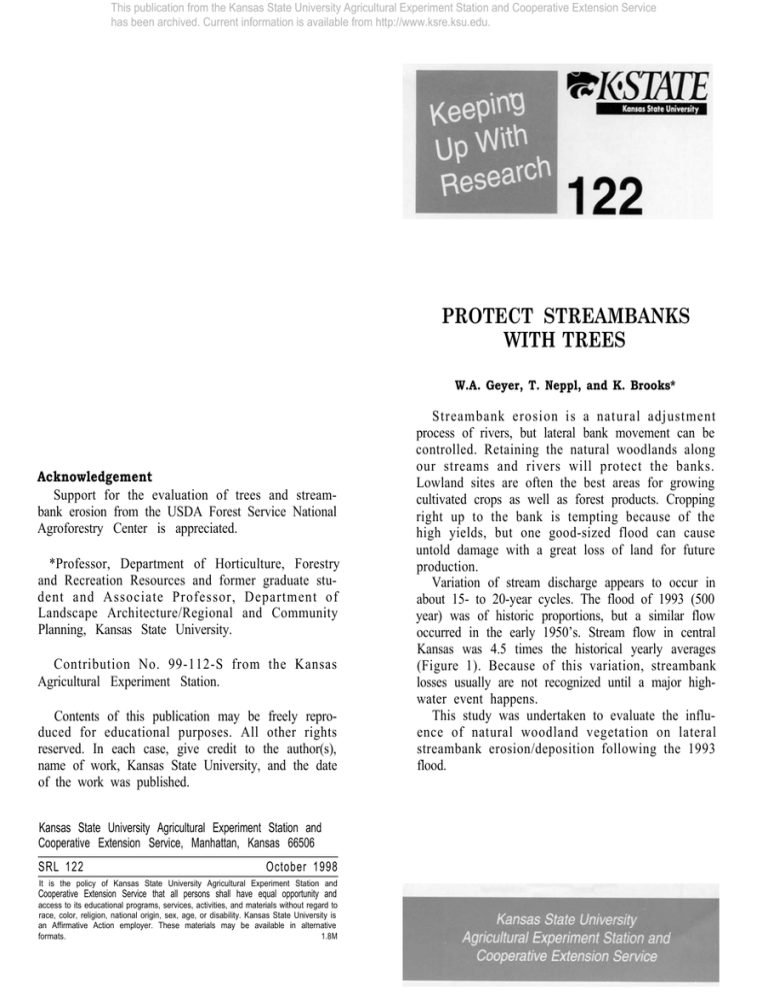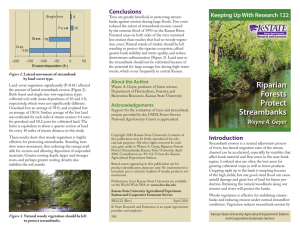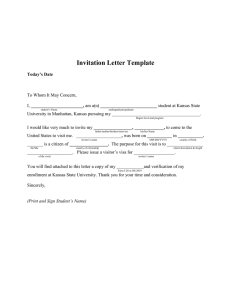
This publication from the Kansas State University Agricultural Experiment Station and Cooperative Extension Service
has been archived. Current information is available from http://www.ksre.ksu.edu.
PROTECT STREAMBANKS
WITH TREES
W.A. Geyer, T. Neppl, and K. Brooks*
Acknowledgement
Support for the evaluation of trees and streambank erosion from the USDA Forest Service National
Agroforestry Center is appreciated.
*Professor, Department of Horticulture, Forestry
and Recreation Resources and former graduate student and Associate Professor, Department of
Landscape Architecture/Regional and Community
Planning, Kansas State University.
Contribution No. 99-112-S from the Kansas
Agricultural Experiment Station.
Contents of this publication may be freely reproduced for educational purposes. All other rights
reserved. In each case, give credit to the author(s),
name of work, Kansas State University, and the date
of the work was published.
Kansas State University Agricultural Experiment Station and
Cooperative Extension Service, Manhattan, Kansas 66506
SRL 122
October 1998
It is the policy of Kansas State University Agricultural Experiment Station and
Cooperative Extension Service that all persons shall have equal opportunity and
access to its educational programs, services, activities, and materials without regard to
race, color, religion, national origin, sex, age, or disability. Kansas State University is
an Affirmative Action employer. These materials may be available in alternative
1.8M
formats.
Streambank erosion is a natural adjustment
process of rivers, but lateral bank movement can be
controlled. Retaining the natural woodlands along
our streams and rivers will protect the banks.
Lowland sites are often the best areas for growing
cultivated crops as well as forest products. Cropping
right up to the bank is tempting because of the
high yields, but one good-sized flood can cause
untold damage with a great loss of land for future
production.
Variation of stream discharge appears to occur in
about 15- to 20-year cycles. The flood of 1993 (500
year) was of historic proportions, but a similar flow
occurred in the early 1950’s. Stream flow in central
Kansas was 4.5 times the historical yearly averages
(Figure 1). Because of this variation, streambank
losses usually are not recognized until a major highwater event happens.
This study was undertaken to evaluate the influence of natural woodland vegetation on lateral
streambank erosion/deposition following the 1993
flood.
This publication from the Kansas State University Agricultural Experiment Station and Cooperative Extension Service
has been archived. Current information is available from http://www.ksre.ksu.edu.
1937
41
45
49
53
57
61
65
69
73
77
81
85
89
1993
Year
Figure 1. Historical mean discharge of the
Kansas River at the beginning point
of the study area.
Procedures
Study Area. The study area was in the Kansas
River Basin, which covers about 60,000 sq miles in
three states. The specific zone of study was a 40-mile
portion near Manhattan, Kansas (Figure 2). The
woody vegetation along the river consists of many
tree species, including cottonwood (Populus deltoides), silver maple (Acer saccharinum), willow
species (Salix sp.), hackberry (Celtis occidentalis),
sycamore (Platanus occidentalis), and elm species
(Ulmus sp.)
Figure 2. Diagram of the river study area.
Tools of Investigation. Aerial photographic
images were chosen to compare pre- and postflood
streambanks (slides were taken in December 1992
and December 1993), using easily identified features
such as riparian vegetation and streambank edge.
Local offices of the Consolidated Farm Service
Agency provided slide images of the study area.
Data Collection Process. Photocopies of the
slides were transferred with a CalCompl digitizing
tablet into a LandCADDI R12 computer-aided drawing (CAD) program file. The photocopies were calibrated to previously digitized, USGS, 7.5 minute,
topographical, quadrangle maps to enable accurate
scaling and analysis of the images. Only features useful in calibrating slide images, such as roads, railroad
tracks, and mile section lines, were digitized from the
quadrangle maps.
Once the base maps were digitized, streambank
edges from the 1992 and 1993 slide images of the
Kansas River were digitized. Notes as to land-cover
condition were made within the drawing as needed.
Then a river centerline was interpolated within the
CAD drawing using the 1992 streambanks as
a guide. The centerline served as a reference for
river position and demarcation and land-cover
classification.
Data collection points were established at regular
500-foot intervals along the centerline in the study
area. At these points, land cover was classified using
the 1992 aerial photographs as references. Erosion
and deposition amounts were estimated by measuring the perpendicular distance from the 1992
streambank to the 1993 streambank at data collection points.
Land-cover vegetative types in the 100-ft zone
next to the 1992 streambank were categorized as:
forest land, cropland, grassland, or single tree-row. A
forested streambank is one on which the dominant
land-cover type (>51%) is woody vegetation. A cropland or grassland streambank is one on which the
dominant land-cover type is either agricultural crops
or grass. Finally, a single tree-row streambank is one
on which a single row of trees exists adjacent to a
nonforest land-cover type.
Vegetation data were collected for both the left
and right side streambanks at every data collection
point and inserted into the CAD program. Data from
each side of the river were pooled.
This publication from the Kansas State University Agricultural Experiment Station and Cooperative Extension Service
has been archived. Current information is available from http://www.ksre.ksu.edu.
Results and Discussion
Data were collected from a total of 204 (103 right
side and 101 left side) streambank points. These data
points were classified as follows: 96 points as forest
land, 37 as cropland, 47 as grassland, and 24 as
single-tree row. Thus, 59% of the banks were tree
lined.
About 62% of the banks had sandy soils, and 38%
had loamy soils. The streams generally were of two
types, meandering (63%) and relatively shallow and
braided (37%). Many of the streambanks were
entrenched.
Land-cover vegetation significantly (1% level)
affected the amount of erosion of the lateral streambank (Figure 3). Both forest and the single tree-row
vegetation types collected soil, with mean depositions
of 10 ft and 4 ft, respectively, which were not significantly different, whereas grassland lost an average of
78 ft, and cropland lost an average of 150 ft. The
surface acreage of the lost land was considered for
each mile of stream erosion: 9.4 acres for grassland
and 18.2 acres for cultivated land. The latter is equivalent to about 1/4 section of land for every 10 miles
of stream distance in this study.
These results showed that woody vegetation is
highly effective in protecting streambanks. Water
movement is slowed by the standing trees, thus
reducing the energy available for erosion and allowing deposition of suspended materials. Greater rooting depth, larger and stronger roots, and perhaps
greater rooting density also stabilize the soil mantle.
Conclusions
Trees have a highly beneficial effect in protecting
streambanks against erosion during large floods. Tree
cover reduced the extent of streambank erosion
caused by the extreme flood of 1993 on the Kansas
River. Forested areas on both sides of the river sustained less erosion than those reaches that had no
woody vegetation cover. Natural stands of timber are
best left standing to protect the riparian ecosystem,
affording greater bank stability and water quality and
reducing downstream sedimentation (Figure 4).
Cultivating land next to the stream bank should be
avoided because of the large acreage loss during high
water events, which occur frequently in central
Kansas.
Figure 4. Natural woody vegetation should be
left to protect streambanks.
Lateral dist.(ft)--erosion/deposition
Figure 3 . Lateral movement of streambank by
land-cover type.



